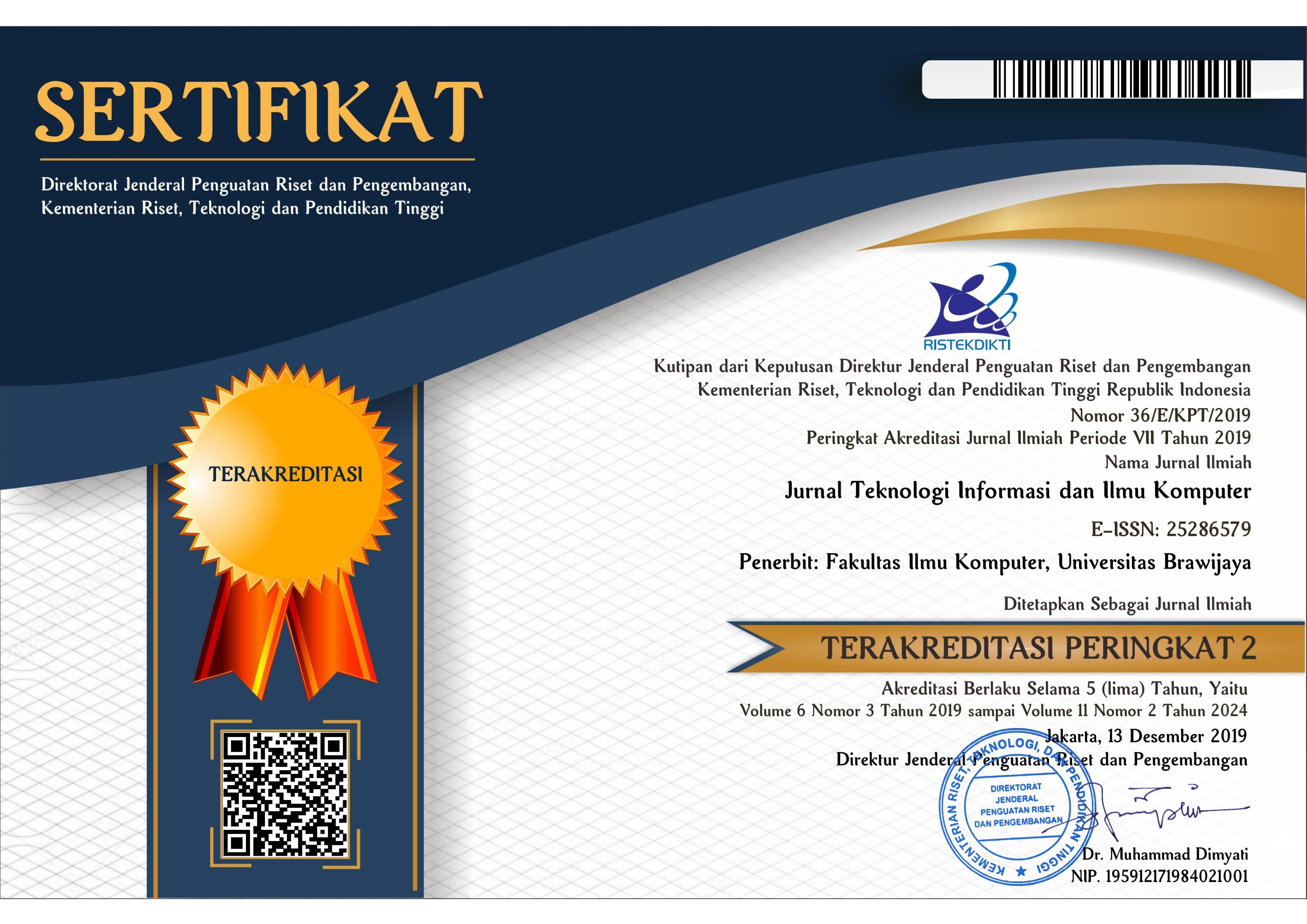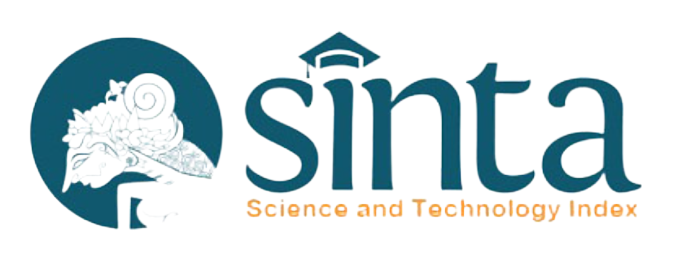Identifikasi Gejala Monkeypox pada Kulit Manusia Menggunakan Arsitektur Efficientnet-B1 dengan Optimalisasi Hyperparameter
DOI:
https://doi.org/10.25126/jtiik.2025125Kata Kunci:
Monkeypox, Deep Learning, EfficientNet-B1, Optimalisasi HyperparameterAbstrak
Monkeypox merupakan penyakit zoonosis yang memerlukan deteksi dini untuk penanganan yang tepat. Penelitian ini merancang model identifikasi gejala Monkeypox pada kulit manusia menggunakan arsitektur EfficientNet-B1 dengan optimalisasi hyperparameter. Dataset yang digunakan terdiri dari 3.192 gambar yang terbagi menjadi dua kelas, yaitu Monkeypox dan Non-Monkeypox. Proses perancangan model melibatkan tahapan identifikasi masalah, pengumpulan data, pre-processing data, perancangan arsitektur model dan pengimplementasian hyperparameter, evaluasi model, hingga analisis hasil. Evaluasi performa dilakukan dengan membandingkan model yang menggunakan optimalisasi hyperparameter dengan model yang tidak dioptimalisasi, menggunakan confusion matrix. Hasil penelitian menunjukkan bahwa model dengan optimalisasi hyperparameter mencapai performa yang sangat baik dengan nilai akurasi 99.22%, precision 99.15%, recall 99.43%, dan F1-Score 99.29%, jauh melampaui model tanpa optimalisasi yang mendapat akurasi pada angka 81.88%. Model yang dioptimalisasi hyperparameter juga menunjukkan efisiensi waktu pelatihan yang lebih baik, hanya membutuhkan 9 epoch untuk mencapai konvergensi, dibandingkan dengan 50 epoch pada model tanpa optimalisasi hyperparameter. Penelitian ini membuktikan bahwa optimalisasi hyperparameter berperan penting dalam meningkatkan akurasi dan efisiensi model untuk mengidentifikasi gejala penyakit Monkeypox, serta membuka peluang untuk pengembangan alat bantu diagnostik berbasis kecerdasan buatan.
Abstract
Monkeypox is a zoonotic disease that requires early detection for proper treatment. This study designs a Monkeypox symptom identification model on human skin using EfficientNet-B1 architecture with hyperparameter optimization. The dataset used consists of 3,192 images divided into two classes, namely Monkeypox and Non-Monkeypox. The model design process involves the stages of problem identification, data collection, data pre-processing, model architecture design and hyperparameter implementation, model evaluation, and result analysis. Performance evaluation is done by comparing models that use hyperparameter optimization with models that are not optimized, using confusion matrix. The results show that the model with hyperparameter optimization achieves excellent performance with an accuracy value of 99.22%, precision 99.15%, recall 99.43%, and F1-Score 99.29%, far exceeding the model without optimization which gets accuracy at 81.88%. The hyperparameter optimized model also showed better training time efficiency, requiring only 9 epochs to reach convergence, compared to 50 epochs in the model without hyperparameter optimization. This research proves that hyperparameter optimization plays an important role in improving the accuracy and efficiency of the model to identify Monkeypox symptoms, and opens up opportunities for the development of artificial intelligence-based diagnostic tools.
Downloads
Referensi
ALTUN, M., GÜRÜLER, H., ÖZKARACA, O., KHAN, F., KHAN, J., & LEE, Y. 2023. Monkeypox Detection Using CNN with Transfer Learning. Sensors, 23(4). https://doi.org/10.3390/s23041783
DEMIR, F. B., BAYGIN, M., TUNCER, I., BARUA, P. D., DOGAN, S., TUNCER, T., OOI, C. P., CIACCIO, E. J., & ACHARYA, U. R. 2024. MNPDenseNet: Automated Monkeypox Detection Using Multiple Nested Patch Division and Pretrained DenseNet201. Multimedia Tools and Applications, 83(30), 75061–75083. https://doi.org/10.1007/s11042-024-18416-4
DESIANA, P., AYU, W., & PRADIPTA, G. A. 2024. SqueezeNet Feature Extraction dan Gradient Boosting untuk Klasifikasi Penyakit Monkeypox pada Citra Kulit. Jurnal Sistem Dan Informatika (JSI).
FAHMI IDRIS, J., RAMADHANI, R., MALIK MUTOFFAR, M., Tinggi Teknologi Bandung Alamat, S., Soekarno Hatta No, J., Lega, K., Bojongloa Kidul, K., Bandung, K., & Barat, J. 2024. Klasifikasi Penyakit Kanker Paru Menggunakan Perbandingan Algoritma Machine Learning. In JMA) (Vol. 2, Issue 2).
GAJERA, H. K., NAYAK, D. R., & ZAVERI, M. A. 2023. A comprehensive analysis of dermoscopy images for melanoma detection via deep CNN features. Biomedical Signal Processing and Control, 79, 104186. https://doi.org/10.1016/j.bspc.2022.104186
KOZLOV, M. 2022. Monkeypox goes global: why scientists are on alert. Https://Doi.Org/10.1038/D41586-022-01421-8, 606(7912), 15–16.
MARTHA, G., & BORORING, G. 2024. Pengembangan Algoritma Machine Learning Untuk Mendeteksi Anomali Dalam Jaringan Komputer. Jurnal Review Pendidikan Dan Pengajaran, 7(1364).
MELLIAN RAMADHAN, I., SANJAYA, S., YANTO, F., & SYAFRIA, F. 2023. Image Classification of Beef and Pork Using Convolutional Neural Network Architecture EfficientNet-B1 1. Indonesian Journal of Artificial Intelligence and Data Mining (IJAIDM), 6(1), 54–62. https://doi.org/10.24014/ijaidm.v2i2
MORALES-HERNÁNDEZ, A., VAN NIEUWENHUYSE, I., & ROJAS GONZALEZ, S. 2023. A survey on multi-objective hyperparameter optimization algorithms for machine learning. In Artificial Intelligence Review (Vol. 56, Issue 8). Springer Netherlands. https://doi.org/10.1007/s10462-022-10359-2
NG, J. (2022, September 1). Perbedaan Cacar Monyet dan Cacar Air. 01 Sep 2022. https://aido.id/health-articles/perbedaan-cacar-monyet-dan-cacar-air/detail
OGOINA FMCP, D., IROEZINDU FWACP, M., IZIBEWULE JAMES MBBS, H., OLADOKUN FWACP, R., YINKA-OGUNLEYE MPH, A., WAKAMA MBBS, P., OTIKE-ODIBI FWACP, B., MUHAMMED USMAN MPH, L., OBAZEE FWACP, E., ARUNA FFPH, O., & IHEKWEAZU FFPH, C. 2020. Clinical course and outcome of human monkeypox in Nigeria. Oxford University Press. https://doi.org/10.1093/cid/ciaa143/5734993
OYEDEJI, O. A., KHAN, S., & ERKOYUNCU, J. A. 2024. Application of CNN for multiple phase corrosion identification and region detection. Applied Soft Computing, 164. https://doi.org/10.1016/j.asoc.2024.112008
PRAMANIK, R., BANERJEE, B., EFIMENKO, G., KAPLUN, D., & SARKAR, R. 2023. Monkeypox detection from skin lesion images using an amalgamation of CNN models aided with Beta function-based normalization scheme. PLoS ONE, 18(4 April).
https://doi.org/10.1371/journal.pone.0281815
PUTERI, K., & SILVANIE, A. 2020. Machine Learning untuk Model Prediksi Harga Sembako. Jurnal Nasional Informatika, 1(2), 82–94.
SUSANTO, L. A., NILOGIRI, A., & HANDAYANI, L. 2023. Klasifikasi Citra Lesi Kulit Serupa Virus Monkeypox Menggunakan VGG-19 Convolutional Neural Network. JUSTINDO (Jurnal Sistem Dan Teknologi Informasi Indonesia), 8(1), 1–9. https://doi.org/10.32528/justindo.v8i1.168
TARUNO, P., NUGRAHA, G., DWIYANTSAPUTRA, R., & BIMANTORO, F. 2023. Monkeypox Classification based on Skin Images using CNN: EfficientNet-B0. E3S Web of Conferences, 465(02031). https://doi.org/https://doi.org/10.1051/e3sconf/202346502031
TENSORKITTY, PAUL, J., AHMED TAZUDDIN, & PEANA TASNIM. 2023. Monkeypox Skin Lesion Dataset. Kaggle. https://www.kaggle.com/datasets/nafin59/monkeypox-skin-lesion-dataset?select=Monkeypox_Dataset_metadata.csv
THORNHILL, J. P., BARKATI, S., WALMSLEY, S., ROCKSTROH, J., ANTINORI, A., HARRISON, L. B., PALICH, R., NORI, A., REEVES, I., HABIBI, M. S., APEA, V., BOESECKE, C., VANDEKERCKHOVE, L., YAKUBOVSKY, M., SENDAGORTA, E., BLANCO, J. L., FLORENCE, E., MOSCHESE, D., MALTEZ, F. M., … ORKIN, C. M. 2022. Monkeypox Virus Infection in Humans across 16 Countries — April–June 2022. New England Journal of Medicine, 387(8), 679–691. https://doi.org/10.1056/nejmoa2207323
WANG, Y., BAI, C., QIAN, X., LIU, W., ZHU, C., & GE, L. 2022. A DC Series Arc Fault Detection Method Based on a Lightweight Convolutional Neural Network Used in Photovoltaic System. Energies, 15(8). https://doi.org/10.3390/en15082877
WIJAYA, R. S., QUR’ANIA, A., & ANGGRAENI, I. 2024. Klasifikasi Penyakit Cacar Monyet Menggunakan Support Vector Machine (SVM). MALCOM: Indonesian Journal of Machine Learning and Computer Science, 4(4), 1253–1260. https://doi.org/10.57152/malcom.v4i4.1417
Unduhan
Diterbitkan
Terbitan
Bagian
Lisensi
Hak Cipta (c) 2025 Jurnal Teknologi Informasi dan Ilmu Komputer

Artikel ini berlisensiCreative Commons Attribution-ShareAlike 4.0 International License.

Artikel ini berlisensi Creative Common Attribution-ShareAlike 4.0 International (CC BY-SA 4.0)
Penulis yang menerbitkan di jurnal ini menyetujui ketentuan berikut:
- Penulis menyimpan hak cipta dan memberikan jurnal hak penerbitan pertama naskah secara simultan dengan lisensi di bawah Creative Common Attribution-ShareAlike 4.0 International (CC BY-SA 4.0) yang mengizinkan orang lain untuk berbagi pekerjaan dengan sebuah pernyataan kepenulisan pekerjaan dan penerbitan awal di jurnal ini.
- Penulis bisa memasukkan ke dalam penyusunan kontraktual tambahan terpisah untuk distribusi non ekslusif versi kaya terbitan jurnal (contoh: mempostingnya ke repositori institusional atau menerbitkannya dalam sebuah buku), dengan pengakuan penerbitan awalnya di jurnal ini.
- Penulis diizinkan dan didorong untuk mem-posting karya mereka online (contoh: di repositori institusional atau di website mereka) sebelum dan selama proses penyerahan, karena dapat mengarahkan ke pertukaran produktif, seperti halnya sitiran yang lebih awal dan lebih hebat dari karya yang diterbitkan. (Lihat Efek Akses Terbuka).














